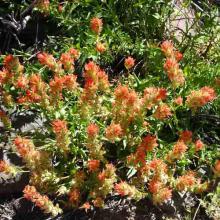Castilleja linariifolia
Common name:
Wyoming Indian paintbrush
Genus:
Castilleja
Family:
Orobanchaceae
Order:
Lamiales
Castilleja linariifolia
Common name:
Wyoming Indian paintbrush
Genus:
Castilleja
Family:
Orobanchaceae
Order:
Lamiales
Castilleja linariifolia
Common name:
Wyoming Indian paintbrush
Genus:
Castilleja
Family:
Orobanchaceae
Order:
Lamiales
Family (Plantae): Orobanchaceae
Orobanchaceae, the broomrapes, is a family of mostly parasitic plants of the order Lamiales, with about 90 genera and more than 2000 species. Many of these genera (e.g., Pedicularis, Rhinanthus, Striga) were formerly included in the family Scrophulariaceae sensu lato. With its new circumscription, Orobanchaceae forms a distinct, monophyletic family. From a phylogenetic perspective, it is defined as the largest crown clade containing Orobanche major and relatives, but neither Paulownia tomentosa nor Phryma leptostachya nor Mazus japonicus.
The Orobanchaceae are annual herbs or perennial herbs or shrubs, and all (except Lindenbergia, Rehmannia and Triaenophora) are parasitic on the roots of other plants—either holoparasitic or hemiparasitic (fully or partly parasitic). The holoparasitic species lack chlorophyll and therefore cannot perform photosynthesis.
Distribution
The family Orobanchaceae has a cosmopolitan distribution, found mainly in temperate Eurasia, North America, South America, parts of Australia, New Zealand, and tropical Africa. The only exception to its distribution is Antarctica, though some genera may be found in subarctic regions.
Life history traits
Orobanchaceae is the largest of the 20–28 dicot families that express parasitism. Apart from a few non-parasitic taxa, the family displays all types of plant parasitism: facultative parasite, obligate parasite, hemiparasites, and holoparasites.
Characteristics
Roots and Stems
Parasitic plants are attached to their host by means of haustoria, which transfer nutrients from the host to the parasite. Only the hemiparasitic species possess an additional extensive root system referred to as the lateral or side haustoria. In most holoparasitic species there is a swollen mass of short, bulky roots or one big swollen haustorial organ, which may be simple or composite, commonly called the terminal or primary haustorium.
Plants are reduced to short vegetative stems, their alternate leaves are reduced to fleshy, tooth-like scales, and have multicellular hairs interspersed with glandular hairs.
The hemiparasitic species (transferred from Scrophulariaceae) with green leaves are capable of photosynthesis, and may be either facultative or obligate parasites.
Flowers
The hermaphroditic flowers are bilaterally symmetrical and grow either in racemes or spikes or singly at the apex of the slender stem. The tubular calyx is formed by 2–5 united sepals. There are five united, bilabiate petals forming the corolla and they may be yellowish, brownish, purplish, or white. The upper lip is two-lobed, the lower lip is three-lobed. There are two long and two short stamens on slender filaments, inserted below the middle, or at the base of the corolla tube, alternating with the lobes of the tube. A fifth stamen is either sterile or lacking completely. The anthers dehisce via longitudinal slits. The pistil is one-celled. The ovary is superior. The flowers are pollinated by insects or birds (e.g. hummingbirds, as in Castilleja).
Fruits
The fruit is a dehiscent, non-fleshy, 1-locular capsule with many very minute endospermic seeds. Fruits of Orobanchaceae are small and abundant and can produce between 10,000–1,000,000 seeds per plant. These are dispersed by the wind over long distances, which increases their chances of finding a new host.
Reference: Wikipedia

